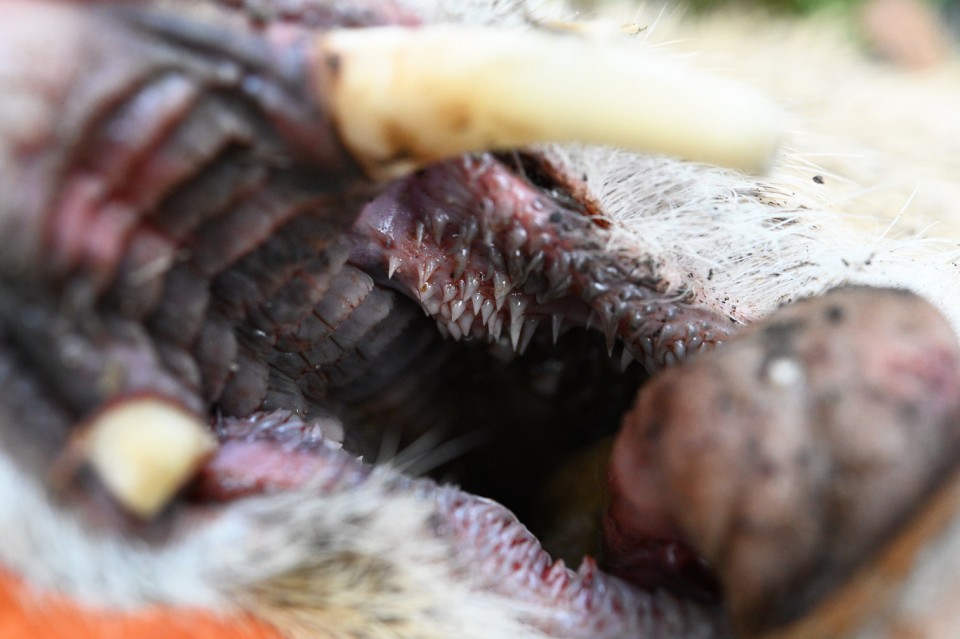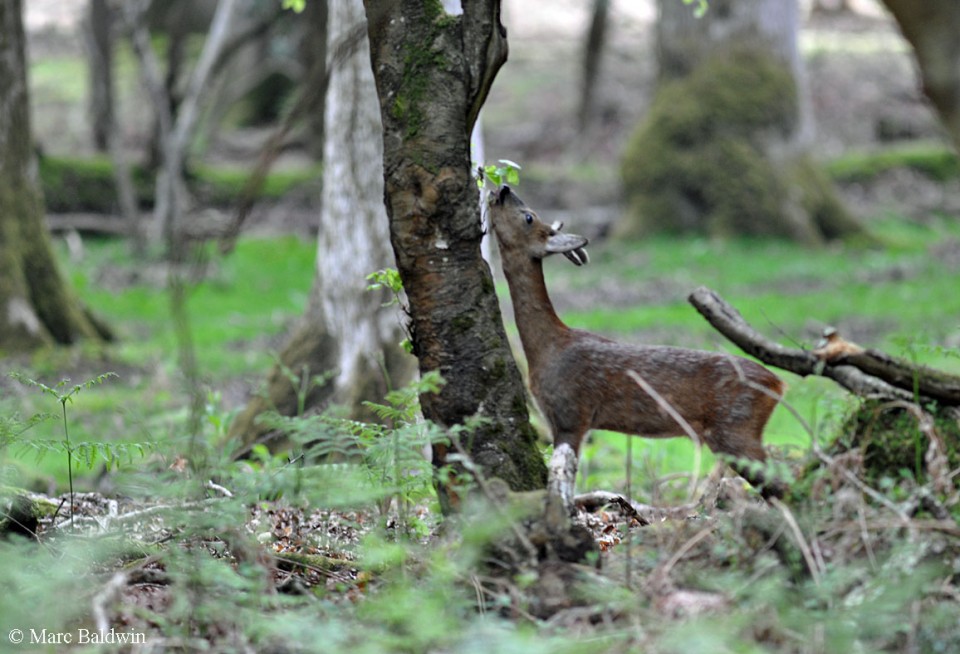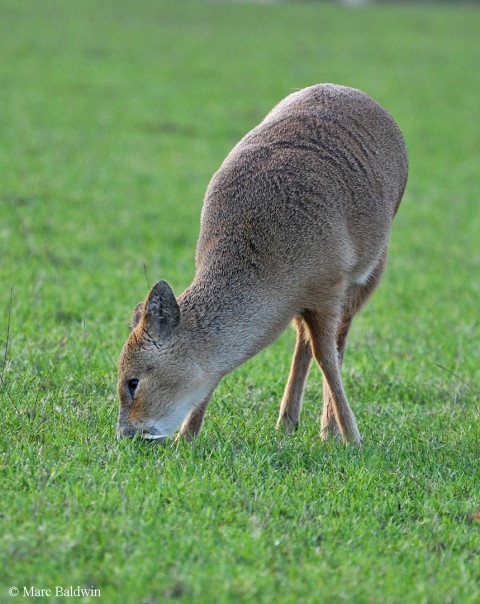Deer (Overview) Feeding - Rumination
The roof of the ruminant mouth consists of a rubbery dental pad (sometimes referred to as the pulvinus dentalis), a hardened anterior section of the mucous membrane known as the hard palate, which is yellowy grey in colour. The top jaw lacks incisors (front teeth), and the in the six in the lower jaw (plus two canines that are modified to such an extent as to be almost indistinguishable from the incisors) work against the dental pad to remove/sever vegetation for chewing. Equally, by grasping the vegetation between the pad and lower incisors, the deer can get the meristem of the grass or sedge blade (i.e., the soft-fibered tips of roots and shoots that are among the most nutritional part of the plant), sometimes even free the roots of some plants, and peel slivers of bark. The tooth arrangement, coupled with adaptations to the jaw musculature allows the lower tooth rows to move across the upper ones such that deer chew with a sweeping grinding (side-to-side) motion. This ensures the plant material is ground against the ridges of the molars and premolars (collectively termed the "cheek teeth"). The cheek teeth break up the cell walls, releasing the digestible contents, while the large molars serve as a mill on which to grind plant material into fine particles.

The feeding process starts in the mouth, and the teeth are an important component of the exercise. Owing to the abrasive nature of vegetation, grasses in particular having abundant silica-rich phytoliths, and the permanent nature of adult mammal dentition, the teeth of grazing and browsing species tend to have tall enamel crowns. This tooth structure is known as hypsodont, which means the teeth have high crowns and enamel that extends past the gum line; the crowns wear down slowly through the animal's lifetime. Originally, we thought that hypsodonty evolved as an adaptation to foraging in open habitat, but a more recent analysis by Manuel Mendoza and Paul Palmqvist, suggests this may be coincidental, and tooth height actually reflects the amount of grass consumed. Whatever the driver, it appears that hypsodonty increases chewing efficiency in grazing deer, as well as extending tooth life, and thus the life of their owner.
The mucous membrane that lines the mouth and cheeks is smooth in most mammals, but in ruminants it is studded with backwards-facing horny cones known as buccal papillae. These papillae help to keep food in the mouth and direct it towards the pharynx, position it such that the molars can grind it, offer some protection to the tissues of the cheek against material that may be dry and coarse, and maintain the bolus in position while the deer chews the cud, which involves large lateral (side to side) movements of the jaw. I have also seen some suggestion that the papillae also increase the surface area of the mouth, allowing simple sugars released during cudding to be absorbed, although I know of no empirical data on this. Studies of some ruminants, domestic goats (Capra hircus), for example, indicate a high degree of mechanical adaptation of the buccal cavity, with several types and shapes of papillae observed, and this appears to be the case for at least some deer species.

Deer are ruminants, which means that they "chew the cud". Indeed, the word ruminant stems from the Latin ruminatus, meaning "to turn over in the mind" or "chew the cud". Cud is thought to have roots in the Old English cwidi, meaning "what has been chewed". More specifically, deer are "foregut fermenters", so-named because the fermentation chamber is ahead of the "true" stomach. Overall, the stomach is compartmentalised into four chambers, each of which has a different role in the digestive process and, in order from the oesophagus to rectum, these are the rumen (sometimes called the "paunch"), reticulum, omasum ("manifold"), and the abomasum ("true" or "glandular" stomach), which empties into the small intestine, which joins the large intestine and finally the rectum. Despite how this list might make it appear, the rumen and reticulum are essentially sections of the same the same functional space (chamber), because material moves back and forth between the two as it's regurgitated for chewing and re-swallowed. Hence, some authors collectively refer to the two as the reticulorumen.
The reticulorumen can be thought equivalent to the incisors; it allows regurgitation so food can be broken down into smaller fragments. Initially, plant material makes its way into these chambers where it is moistened and mixed with fermenting microorganisms - the result is a partially digested paste (cud). An expansion of the chest produces a vacuum in the upper rumen that causes some of the cud to be sucked back up into the oesophagus. A reverse peristaltic wave then pushes the clump of cud, or bolus, up the oesophagus into the mouth where it's mixed with more saliva and chewed again, before being re-swallowed. This process is known as chewing the cud, or simply cudding, and is done while the animal is resting. In his 2007 book Deer Watch, Richard Prior notes that cud chewing seems to be a relaxing activity for deer; they lie with eyes half-closed and a slight hiccup and ripple in the throat signals the re-arrival of a ball of food.

The primary function of the rumen is one of fermentation and particulate breakdown. Indeed, the rumination process serves to further breakdown the food particle size, increasing the surface area available for the microbes in the rumen to work on, while the act of chewing stimulates saliva that acts as a buffer to the acid in the rumen (which must be kept within fairly tight limits of pH). At the same time, microorganisms are regurgitated with the cud and so become more thoroughly mixed with the digesta as it's chewed. The process of chewing the cud also increases the effective length of the digestive tract, meaning that the microbes have longer to breakdown the plant material. Overall, very little actual digestion takes place in the rumen, although a reasonable amount of fatty acids are liberated from the food here; some authorities estimate that as much as 40% of the deer's energy may be obtained by absorption of fatty acids and sugars from the fermentation of cellulose through the rumen wall.
The cud is re-swallowed and passes back down into the rumen. As the contractions continue to churn this chyme (pronounced "kime", from the Greek chymos, meaning "juice"), a mixture of plant material, microorganisms and liquid known or, as Rory Putman described it in his The Natural History of Deer, "a murky suspension of tiny food particles and micro-organisms", some is pushed into the reticulum. Any particles sufficiently small can pass through the sieve-like structure at the bottom of the reticulum, into the omasum, while larger particles are once again churned and regurgitated. The reticulum lining is covered with a framework of ridges, forming a honeycomb pattern and serving to increase the surface area over which some absorption can occur.

In the omasum the material undergoes muscular processing (i.e., grinding) during which most of the water is removed and more in the way of fatty acid absorption occurs. The omasum has a heavily-folded lining allowing for between 60% and 70% of the water to be absorbed, along with inorganic minerals such as magnesium, and any fatty acids that made it through the reticulorumen. It seems that larger particles can be pushed back into the reticulum for further digestion, should they make it through the reticulo-omasal orifice. From the omasum, the chyme moves into the fourth and final chamber (the abomasum) where the majority of digestion takes place and where gastric juices, including hydrochloric acid, are secreted. As such, the digestion of fats, carbohydrates and proteins progresses as it does in other vertebrates and the products are sequestered into the bloodstream. The epithelium (lining) of the abomasum has gastric pits called foveolae with gastric glands underneath them; these contain hydrochloric acid-producing parietal and zymogenic cells that make digestive juices, similar to our stomachs.
The majority of saccharides, amino acids and peptides in the abomasum are taken up by the microorganisms doing all the work in the rumen and put towards their growth and multiplication. As the microbial population grows, some invariably get washed out of the reticulorumen with the chyme, where they're killed by the abrupt change in acidity and are digested -- it is estimated that up to 90% of a ruminant's amino acids are obtained in this way. The digestion of microbes is also an important source of glucose in starch-poor diets. Consequentially, deer are sometimes said to "farm" microorganisms, obtaining their essential amino acids by digesting them as they leave the reticulorumen. From the abomasum, the food eventually progresses to the small intestine where nutrients are absorbed. The cecum provides additional fermentation and absorption.
For most of the year, faeces are produced as small dry pellets. Ruminants possess a spiral colon and faecal pellet formation begins there. During their radiographic study of the lesser mouse deer (Tragulus javanicus), published in Pertanica during 1988, Ken Richardson and his colleagues observed elongated faecal pellets were first detected in the spiral colon, while pellet length was substantially shorter by the time they had reached the descending colon and they were beginning to clump together. As mentioned, most of the water is absorbed in the omasum, and the digesta is progressively dried out as it progresses through the large and small intestines. The intestines are long, and material moved by peristalsis, so the increasingly desiccated material is formed into pellets for excretion.
Why do deer need such an elaborate digestive system? Well, unsurprisingly, the answer lies in the type of food they eat: plant material. No mammals are able to efficiently break down plant matter; we don't have the correct enzymes for the job. Consequently, when we eat fruit and vegetables we only get the nutriment in the liquid contents of the cell, which represents only about 20% of the total energy contained in the material, because most is bound within the fibrous cell wall. The cell wall of plants consists of four main compounds: cellulose; hemicellulose; lignin; and pectin. To get at this energy (i.e., proteins, fats and sugars), both the tissue itself and these four organic polymers that make it up must be broken down, but while the tissue itself can be broken down fairly effectively by chewing, the polymers are tough and resistant to digestion.
The populations of microorganisms in the stomachs of ruminants can breakdown the cellulose and other structural compounds to release fatty acids, amino acids, peptides, sugars and various simple nitrogenous compounds (e.g., ammonia) that their host can absorb and use for energy. Using microbes in this way is referred to as syntrophism, and this "arrangement" with the bacteria and protozoa make ruminants some of the most effective animals on the planet at converting the polysaccharides (long-chained sugars) in grass to protein (meat). So effective is the process, in fact, that ruminants can access between 50% and 60% of the total energy contained within the plant material.
What this means in practice is that deer are able to take advantage of nutritious young herbage, but are also able to make the best of even low quality forage. Obtaining essential amino acids, vitamins and minerals via digestion of microbes means that ruminants can "divvy up" resources to a much finer scale, allowing species to specialise on a narrow range of plants. Additionally, by making use of a storage vat (the rumen), deer can eat considerable quantities at a single sitting and retire to a safer spot to digest the meal.
The process of rumination is certainly a good way of utilising the energy available in the structural tissue of plants; but it's not without its disadvantages. Efficient utilisation of cellulose takes time; to get access to 60% of the bound-up sugars may take up to 80 hours, which means a considerable amount of time must be devoted to feeding and may necessitate acceptance of low quality forage. High quality browse/graze can be geographically and seasonally patchy, and the longer the digestion time the less selective the animal can be, or the more restrictive a species' habitat requirements are. Deer typically have small rumens, which allows for faster digestive throughput, meaning they can feed less often and spend more time searching out good quality food, but the trade-off is less efficient digestion of cellulose.

As we shall see in the gut flora/fauna section, a further disadvantage of this type of digestive system is that it becomes highly food-dependent -- the microbial community in the stomach is tailored to digest specific types of plant material, which means that deer cannot rapidly switch foods.